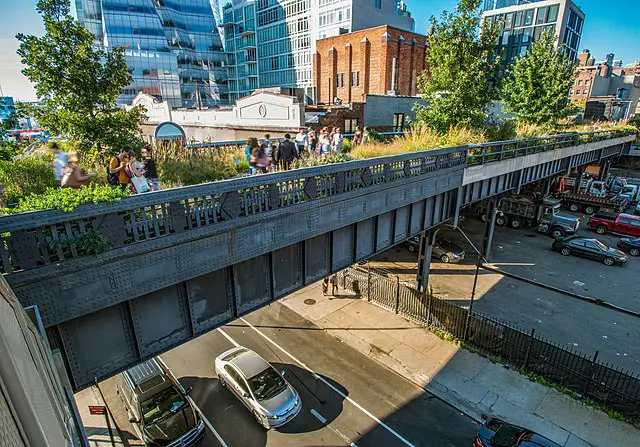
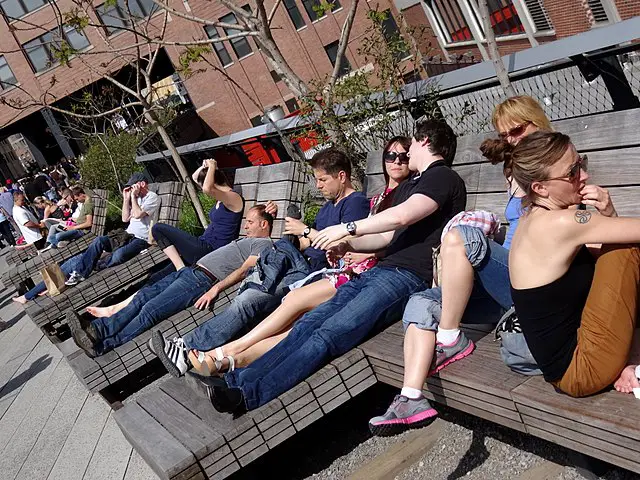
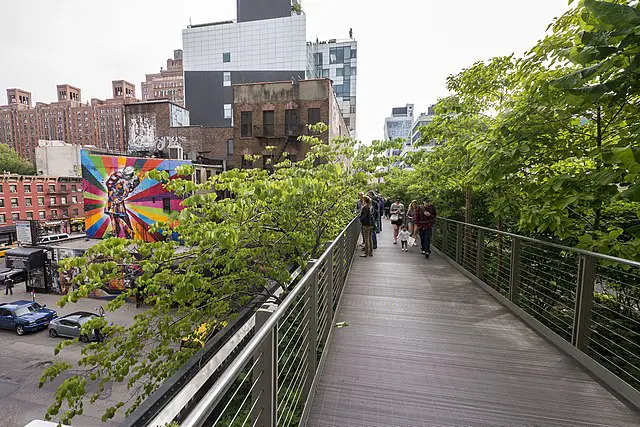
The High Line has been transformed from a relic into one of New York City’s most innovative public areas. An abandoned railway line has been turned into a park that gives locals and visitors alike a chance to unwind while admiring the public artwork, plants, and cityscape vistas in all directions. Almost everyone who visits the city now considers walking the High Line to be a must-do experience since it opened in 2009. You can practically stroll through history along this roughly 2-mile section of the city’s historic rail line on Manhattan’s West Side, from the busy Meatpacking District to Hudson Yards at West 34th Street. You will be more than satisfied with the promenade’s special combination of enchanted botanical gardens and urban immersion, as will your Instagram feed. Even though it may be difficult to imagine now, food used to be delivered by street-level freight trains through lower Manhattan. The city built an elevated rail line to address the issue because it was evident that this put pedestrians in perilous situations. The first West Side Elevated Line, which ran across downtown and was inaugurated in 1934, carried meat, dairy, and produce while frequently cutting through structures to facilitate delivery. Rail use decreased as the century went on and trucking gained popularity.
The West Side Elevated Line faded into obscurity, and parts of it were actually demolished, much like Grand Central Terminal. An urban forest was rising above the streets of New York City as vegetation started to organically encroach on the rail line. Fortunately for all of us, a conservation organisation intervened and started promoting the park’s preservation in 1999. To stimulate suggestions for possible uses of the old music, they held a “ideas competition,” which produced some… unusual submissions. A few others wished it might develop into a water park or a roller coaster. The new High Line’s initial segment debuted in 2009. Today, it is a 1.45-mile elevated promenade with over 500 different plant and tree species on display, as well as public events. The pool will probably have to wait, I suppose.
A stroll across this park isn’t really a quick stroll in the park, given that the High Line is so long. Continue reading for advice on where to begin as there is a lot to see and do up there. One of the primary draws to the High Line is its artwork. The collection up here includes both domestic and foreign artists, from up-and-coming talent to established masters. Nearly all forms of art, from sculpture to multimedia to live performances to murals covering entire building facades, were included by the curators. The best part is that viewing is entirely free. The Sleepwalker, the strangest piece of art on the walk, must be photographed no matter what.
.
Another notable landmark in midtown Manhattan is Grand Central Terminal. The 4, 5, 6, 7 or S trains can take you to the station. If you only have time for a quick glance, be aware that the station is open every day at 5:15 a.m. for no charge. to 2 a.m. The hours of the stores and restaurants at Grand Central are more constrained; for information on these hours, as well as information on tours, station maps, and train schedules. You may grab some lunch or go shopping ’til you drop at this lovely train station, but recent visitors prefered to simply take it all in. Take some pictures of the elaborate beaux-arts neo-classical facade before you go inside. You will find gleaming marble floors, gold and nickel-plated chandeliers, and a sky-themed ceiling inside the renowned main concourse.
The Information Booth clock, the Whispering Gallery, and Grand Central Market, a food market with European influences that sells produce, gourmet goods, and delicacies, are additional must-sees. The upmarket (Cipriani Dolci and The Campbell Bar), legendary (Grand Central Oyster Bar & Restaurant), and quick and simple (Subway) are just a few of the dining alternatives (Shake Shack). There are, as noted, a tonne of places to shop, although most tourists advise leaving the majority of Grand Central’s expensive goods in the store. Visit The New York Transit Museum Store in the shuttle tunnel if you’re looking for a memento with a railway theme. The train station is referred to be “iconic” by visitors, who describe it as a lovely place to stroll around or stop for a meal and people-watch.

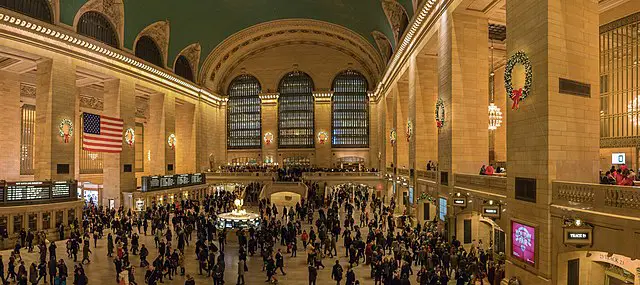


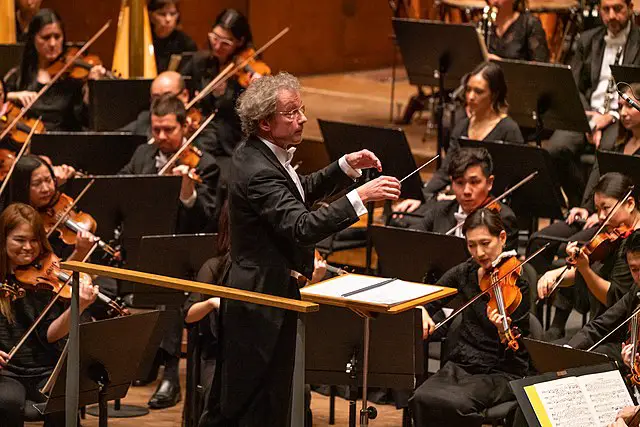
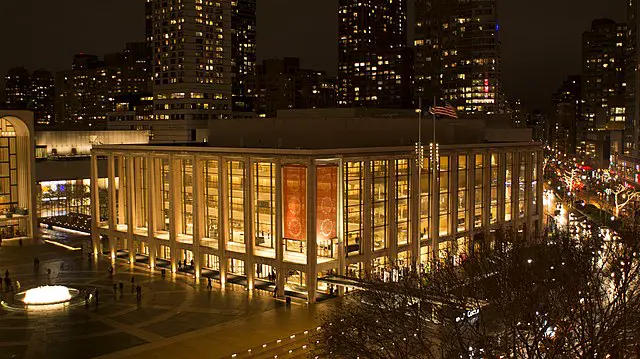


Midway through the 1950s, planning was under way for Lincoln Center, one of the foremost cultural centres to be found. After the first stone was laid in 1959, a number of modern works of art, including six theatres, a school, a library and museum, a fountain, and manicured parks, were all finished within ten years. The Metropolitan Opera House, the New York State Theater (now the David H. Koch Theater), and what was once Philharmonic Hall, the first structure in the complex to be finished, are the three primary structures that surround the plaza and fountain in the complex. In 1973, Philharmonic Hall was renamed Avery Fisher Hall, and in 2015, it was renamed once more in honour of Brooklyn-born businessman and philanthropist David Geffen. Leading American architects created these structures, together with the Vivian Beaumont Theater, the New York Public Library, and the Juilliard School, which are all covered with Italian travertine.
At the south-west corner is where you’ll find Damrosch Park. Connotations, a brand-new work by Aaron Copland, was performed as part of the inauguration event for Philharmonic Hall on September 23, 1962, under the direction of Leonard Bernstein. Samuel Barber, Henry Cowell, and Virgil Thomson were among the other composers who attended the opening-night concert in addition to Aaron Copland. Max Abramovitz, the architect of Philharmonic Hall, hired sculptor Richard Lippold to create a sizable, site-specific piece for the building’s Promenade. Lippold is known for creating large public art pieces in collaboration with architects, such as “Flight” in the Vanderbilt Avenue entrance to the Pan Am (now Met Life) Building and the bronze rods that hang from the ceiling of the bar room in the former Four Seasons Restaurant in the Seagram Building. Most people agree that Lippold’s finest is the “Orpheus and Apollo” work from the Lincoln Center. This massive 190-foot-long piece, which is made up of two asymmetrical groups of 190 thin Muntz (a copper and zinc alloy) cascading plates held by gold wires, was placed in 1962. The two escalators in the lobby were overshadowed by the large mass of each group. The sculpture was a significant component of the hall’s interior public areas and was clearly visible from the Lincoln Center plaza. The architect Max Abramovitz requested that Lippold “create sculpture that would float in space and relate in a contemporary manner to the interior of the foyer just as the magnificent chandeliers of a previous day took command of their space,” and the sculpture, despite its enormous scale and five-ton weight, appeared as a light and dynamic work. The sculpture was taken down and put in storage in 2014. It won’t be reinstalled at Geffen Hall in spite of loud complaints, including the nomination of the piece by the Preservation League of New York State as one of the year’s Seven to Save most endangered heritage sites in 2020. Instead, it was revealed in 2021 that the artwork would be positioned in the main terminal’s central hall of the rebuilt LaGuardia Airport.
The greatest standards for quality in symphony, theatre, dance, opera, and musical education are held by Lincoln Center, which takes great pride in this. However, it’s incredibly difficult to find tickets. Due to the fame and popularity of both ballet and opera performances, the majority of tickets are sold out at the start of the season. You may take a guided behind-the-scenes tour with the New York Pass and view all the stages of prominent venues like the Metropolitan Opera House, David Geffen Hall, and David H. Koch Theater. Your tour guide will explain the structures’ past, and you could even get to watch a rehearsal in action!
